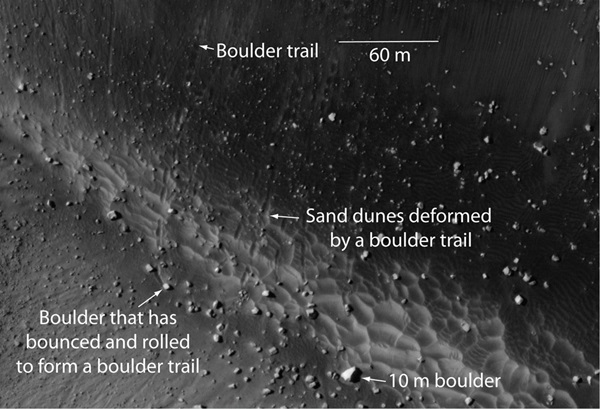Key Takeaways:
With High Resolution Imaging Science Experiment (HiRISE) imagery, the research team examined boulders along a fault system known as Cerberus Fossae, which cuts across a young (a few million years old) lava surface on Mars. By analyzing boulders that toppled from a martian cliff, some of which left trails in the coarse-grained soils, and comparing the patterns of dislodged rocks to such patterns caused by quakes on Earth, the scientists determined that the rocks fell because of seismic activity. The martian patterns were not consistent with how boulders would scatter if they were deposited as ice melted — another means by which rocks are dispersed on Mars.
Gerald Roberts, an earthquake geologist with Birkbeck, an institution of the University of London, said that the images of Mars included boulders that ranged from 6.5 to 65 feet (2 to 20 meters) in diameter, which had fallen in avalanches from cliffs. The size and number of boulders decreased over a radius of 62 miles (100 kilometers) centered at a point along the Cerberus Fossae faults.
“This is consistent with the hypothesis that boulders had been mobilized by ground-shaking, and that the severity of the ground-shaking decreased away from the epicenters of Mars quakes,”
Roberts said.
The team compared the pattern of boulder falls and faulting of the martian surface with those seen after a 2009 earthquake near L’Aquila in central Italy. In that event, boulder falls occurred up to approximately 31 miles (50km) from the epicenter. Because the area of displaced boulders in the Mars quakes stretched across an area approximately 124 miles (200km) long, the quakes were likely to have had a magnitude greater than 7, the researchers estimated.
By looking at the tracks that the falling boulders had left on the dust-covered martian surface, the team determined that the Mars quakes were relatively recent — and certainly within the last few percent of the planet’s history — because martian winds had not yet erased the boulder tracks. Trails on Mars can quickly disappear. For instance, tracks left by NASA robotic rovers are erased within a few years by martian winds, whereas other sheltered tracks stick around longer. It is possible, the scientists concluded, that large-magnitude quake activity is still occurring on Mars.
The existence of Mars quakes could be significant in the ongoing search for life on Mars, the researchers stated. If the faults along the Cerberus Fossae region are active, and movements of magma related to the nearby volcano, Elysium Mons, drive the quakes the energy provided in the form of heat from the volcanic activity under the surface of Mars could be able to melt ice. The resulting liquid water, they noted, could provide habitats friendly to life.










